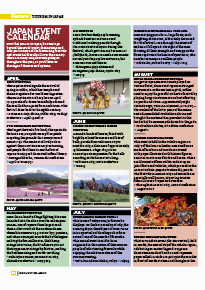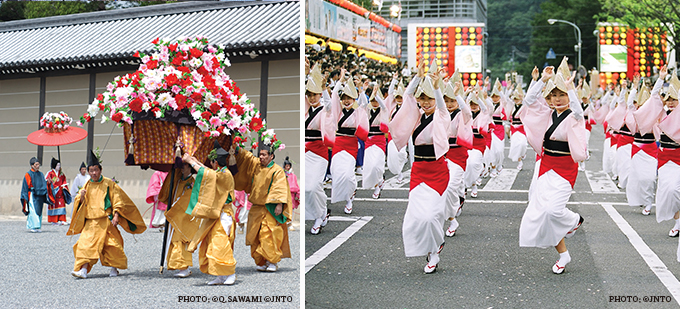Home > Highlighting JAPAN >Highlighting Japan April 2015>Tourism in Japan
Highlighting JAPAN

Tourism in Japan
Japan Event Calendar

Now that you are in Japan, be sure to go beyond the usual tourist destinations and take part in some of the fascinating festivals and events held locally all over the country. There are many unique events going on throughout the year, so you’ll have no shortage of chances and options.
April
Yayoi Festival
The Yayoi Festival signals the arrival of spring in Nikko, which has temples and shrines registered as World Heritage sites. The main attraction takes place on April 17: a parade of a dozen beautifully adorned floats called hana-yatai from each town. This festival dates back to the eighth century.
Futarasan Jinja Shrine, Nikko City / Tochigi Prefecture, April 13 and 17
Fuji Shibazakura Festival
The largest festival of its kind, this spectacle features 800,000 pink moss phlox petals carpeting the grounds that sweep toward Mount Fuji. The contrast of lively colors against the mountain scenery is stunning, and people flock here to see the foot of Japan’s iconic peak decorated in floral finery.
Kawaguchikocho, Yamanashi Prefecture, April 18 to May 31
May
Hamamatsu Festival
More than a hundred huge fighting kites are launched into the skies over the Nakatajima Dunes—one of Japan’s three largest sand dunes—that overlook the Enshunada Sea. These kites measure 3.5 meters by 3.5 meters, and when a trumpet sounds the battle begins. Making the five-millimeter-thick hemp strings intertwine, the kite-fliers try to cut their opponents’ strings by friction, making the battle exciting and worth watching.
Nakatajima Dunes, Hamamatsu City, Shizuoka Prefecture, May 3 to 5
Aoi Matsuri
Some five hundred people wearing splendid ancient costumes and traditional makeup parade through the main streets of Kyoto during this festival, which got its name because aoi (hollyhock) leaves are used as ornaments not only on the people’s costumes, but even on cows and horses.
Shimogamo-jinja Shrine and Kamigamo-jinja Shrine, Kyoto City, May 15
June
Chagu Chagu Umako Horse Festival
Around a hundred horses, fitted with brightly colored harnesses and lots of bells, parade from Takizawa City to Morioka City, a distance of approximately 15 kilometers. Chagu chagu is an onomatopoeic expression for the bells sounding as the horses trot along.
Takizawa City, Iwate Prefecture, June 13
July
Sumidagawa Hanabi Taikai
This is one of Tokyo’s major fireworks displays. On the last Saturday of July, the evening sky in the old part of town turns into a spectacle of dazzling colors from several tens of thousands of fireworks. This annual event is said to have originated in the custom of the common people of Edo viewing fireworks while enjoying the relative coolness of the summer evening.
Taito-ku and Sumida-ku, Tokyo, July 25
Hakata Gion Yamakasa Festival
Men carrying yamakasa—large floats, each weighting about a ton, elaborately decorated for this festival—race through the streets of Hakata at full speed. The sight of the men focusing all their strength and energy on the floats captivates the hearts of spectators, who number as many as a million people.
Hakata-ku, Fukuoka City, July 1 to 15
August
Miyajima Kangensai Festival
Kangen is Japanese court music played on various flutes, drums and Japanese stringed instruments. In the ancient capital, nobles used to enjoy the graceful orchestra festival by playing kangen instruments on boats floating on ponds and rivers. Approximately eight centuries ago, Taira-no-Kiyomori (1118-1181)—the warlord of the latter years of the Heian Period—remodeled Itsukishima Shrine and brought the customs then prevalent to this land to hold a ceremony dedicated to the gods.
Itsukushima Shrine, Hiroshima Prefecture, August 1
Aomori Nebuta Matsuri
This event is held in the Tohoku region on July 7 of the lunar calendar. Massive frames made of bamboo and wood are covered with paper illustrated with historic figures, samurai warriors and birds and beasts. These are illuminated from within and set up on yatai floats and vehicles, which proceed in the Aomori Nebuta (Neputa in Hirosaki) parade. The festivals in Aomori City and Hirosaki are especially well known, attracting tourists from all areas of Japan and overseas.
Throughout Aomori City, Aomori Prefecture, August 2 to 7
Sendai Tanabata Matsuri
This is a Tanabata event (the Star Festival) held in Sendai, the central city of the Tohoku region, celebrating an ancient legend. Gorgeous decorations made of bamboo and Japanese paper called sasatake are put up in the arcades in front of Sendai Station and throughout the city in what appears to be a contest to come up with the most striking colors and displays.
Sendai City, Miyagi Prefecture, August 6 to 8
Awa-Odori Folk Dance Festival in Tokushima
This Tokushima festival features folkdances performed to welcome the souls of ancestors during the O-bon season (mid-August). It is well known throughout Japan for the words “It’s a fool who dances and a fool who watches!” that are voiced to set the rhythm, regardless of their meaning.
Tokushima City, Tokushima Prefecture, August 12 to 15
September
Owara Kaze-no-Bon Festival
This traditional folk event is designed to appease the wind and appeal for a bountiful crop, and takes place every year for three days from September 1. It corresponds to the 210th day from the first day of spring according to the traditional Japanese calendar, and is considered the time of the year that is often beset by calamities such as typhoons. Although there are many explanations about its origins, it is generally believed that the O-bon ritual of paying homage to ancestors was merged with a festival praying for a rich harvest.
Toyama City, Toyama Prefecture, September 1 to 3
October
Takayama Matsuri Autumn Festival
The Takayama Festival, cited as one of Japan’s three most beautiful festivals, actually is a combination of two festivals: the Sanno Matsuri at Hie Shrine and the Hachiman Matsuri at Sakurayama Hachiman Shrine. The Hachiman Matsuri, held annually on October 9 and 10, prompts local inhabitants to start their winter preparations. The greatest attractions are the eleven yatai floats, which are designated as significant intangible folk cultural assets.
Takayama City, Gifu Prefecture, October 9 and 10
Nagasaki Kunchi Festival
This autumn festival held at Suwa Shrine has a history of 370 years, and is now held every year for three days starting on October 7 in accordance with the solar calendar, drawing large numbers of tourists from both inside and outside Nagasaki Prefecture.
Kaminishiyama-machi, Nagasaki City, October 7 to 9
Tokyo International Film Festival
The Tokyo International Film Festival celebrates its twenty-seventh year in 2015. It is Japan’s one and only international film festival recognized by the International Federation of Film Producers Associations, also Asia’s largest, and is always a lively showcase for cinematic entertainment.
TOHO Cinemas Roppongi Hills, Tokyo, October 22 to 31
Tokyo Motor Show
This trade fair offers a chance to see the latest automotive designs and technologies, and is considered one of the top five motor shows in the world. This year marks the forty-fourth show, and will have the theme “With more freedom . . . change for cars, change for lifestyles, change for society.”
Tokyo Big Sight, October 29 to November 8, December
Oga Namahage Festival
This festival features a tradition passed down from ancient times around Oga City in Akita Prefecture. On New Year’s Eve, a group consisting of two to three young village men disguise themselves as a rather grotesque deity called Namahage, resembling an oni (demon). Wearing large masks, straw raincoats and loincloths, holding wooden knives and pails, they go dancing along and visiting houses at night, roaring and frightening misbehaving children and others.
Oga City, Akita Prefecture, December 31, January
Dezome-shiki
Organized by the Tokyo Fire Department, this event is held to pray for a safe year. Although similar events are held throughout Japan, this spectacular New Year’s Parade of Firemen features over a hundred fire engines and helicopters, and large-scale firefighting and emergency drills.
Tokyo Big Sight, January 6, February
Sapporo Snow Festival
Rows of small and large snow sculptures are created and displayed at three sites in Sapporo City during this snow festival, which draws two million people, including many overseas tourists. Odori Park, located in the city center, serves as the main venue, and a space extending 1.5 kilometers is transformed into a snow museum. International Square becomes the stage for the International Snow Sculpture Contest, at which over ten teams from the world over compete every year.
Sapporo City, Hokkaido, Seven days, starting in the second week of February
March
Omizutori
Priests at Todai-ji Temple, famous for its enormous statue of Buddha, confess their sins before the Eleven-Faced Kannon (the goddess of mercy) enshrined in Nigatsu-do Hall, and also pray for world peace and a rich harvest for fourteen consecutive days. This ritual, called Shuni-e, has been practiced since 752.
Todai-ji Temple, Nara City, March 1 to 14
© 2009 Cabinet Office, Government of Japan






